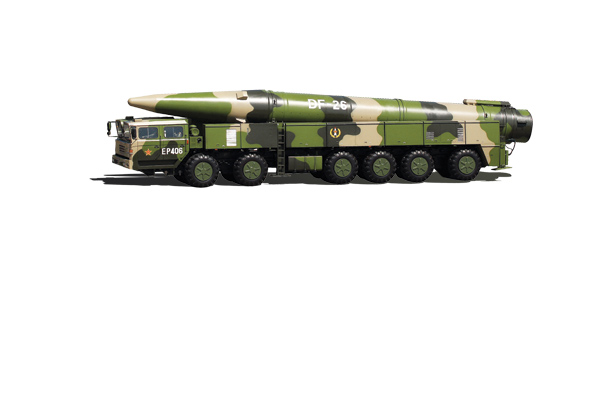Missile capacity gives PLA cutting edge
By Zhao Lei (China Daily) Updated: 2015-09-04 08:46Geopolitical influence
 |
|
DF-26 intermediate-range ballistic missile. WANG ZHUANGFEI/CHINA DAILY |
Gao Zhuo, a military observer in Shanghai who is familiar with the PLA's modernization drive, speculated that to destroy targets along the second island chain, the DF-26's minimal range should be no shorter than 3,500 km, similar to that of the SS-20 Saber of the former Soviet Union. The Chinese missile itself is much shorter, which indicates that its engine is much more powerful than the SS-20.
PLA military theorists conceive of two island "chains" as forming a geographic basis for China's maritime defensive perimeter. The precise boundaries of these chains have never been officially defined by the Chinese government. By commonly accepted definitions, the first island chain refers to a series of islands that stretch from Japan in the north to the Philippines in the south. The second island chain runs from the Bonin Islands in the north and moves southward through the Northern Mariana Islands, Guam, and the Caroline Islands.
With its cutting-edge guidance system and a large conventional warhead, the DF-26 is able to pose a serious threat to ships, he said, adding that the appearance of the missile in the parade signals that the PLA already has a certain number of DF-26 units that are combat-ready.
The US news website Washington Free Beacon reported in March 2014 that the DF-26 is carried on a road-mobile chassis and uses solid fuel. "The fuel and mobility allow the missile to be hidden in underground facilities and fired on short notice, making it very difficult to counter in a conflict," it said.
In a June report, the website quoted Richard Fisher, an expert on Asian military affairs at the Washington-based International Assessment and Strategy Center, as saying that DF-26 will be tasked with delivering China's WU-14 hypersonic glide vehicle, a next-generation strike platform said to be capable of flying at a speed of up to Mach 10, or 12,359 km per hour, and maneuvering to avoid detection and missile defense interceptors.
In an article published earlier by Russia's Sputnik news website, Vasily Kashin, a senior analyst with the Moscow-based Center for Analysis of Strategies and Technologies, said that new missiles such as the DF-16 and DF-26 will enable China to hit any given target in the Asia-Pacific, including military installations along the first and second island chains.
"The fact that these missiles were developed and manufactured at a comparatively fast speed indicates China's missile industry is growing exponentially," the Russian expert wrote. "Actually, China has probably outperformed what the United States and the Soviet Union achieved in terms of intermediate-range ballistic missiles in the 1980s."
The US and the Soviet Union were the top two developers of intermediate-range ballistic missiles before 1987 when the two superpowers signed the Intermediate-range Nuclear Forces Treaty, which obliged the two to eliminate their intermediate-and short-range ballistic missiles.
Senior Colonel Hou Xiaohe, a strategy expert at the PLA National Defense University, said the deployment of the DF-21's anti-carrier variant and the DF-26 can substantially change the geopolitical situation in the western Pacific region.
"They are the most effective deterrents to China's potential adversaries," he said.




